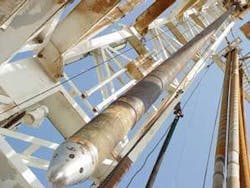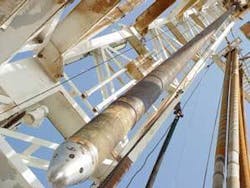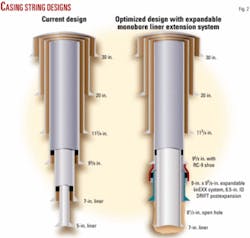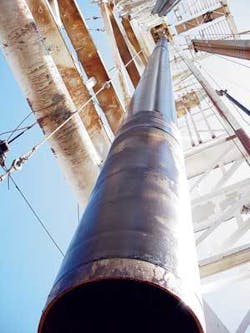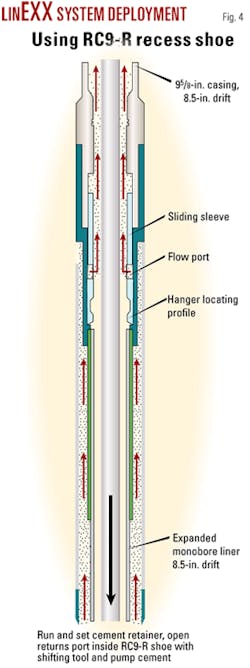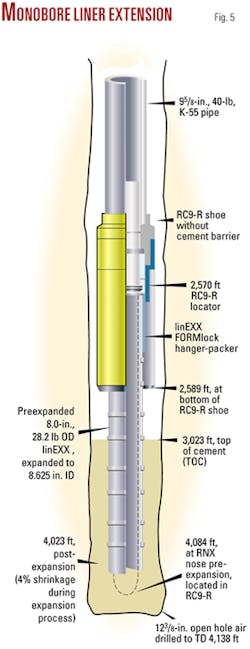SPECIAL REPORT: BP, Baker run first expandable monobore liner extension system
In September 2006, BP and Baker Oil Tools achieved an industry milestone with the successful installation of the world’s first monobore expandable liner extension system, in a commercial well in BP’s Arkoma asset in southeast Oklahoma (Fig. 1).
The successful installation and expansion of 1,514 ft (461 m) of Baker’s 8-in. linEXX solid expandable system below the 9 5/8-in. parent casing proved the feasibility of solid expandable tubulars and enables operators to plan and drill deeper wells with larger hole sizes at the reservoir.
Earlier in the year, the successful installation of recess shoes in four North Sea wells set the stage for future monobore contingency applications of solid expandable tubulars to isolate trouble zones, such as reactive shales, subsalt environments, and low-fracture-gradient sections, and then drill ahead without having to reduce critical hole size.
The Baker system is currently the only solid expandable monobore liner extension system available on the market. Key enabling features and benefits of the system include:
- A casing shoe with a recessed internal diameter (ID) and location profile that enables the liner to be anchored on the bottom of the parent casing and then expanded into the shoe with no ID size restriction below the parent casing. The recess shoe distinguishes the Baker expandable system from others that have an ID size restriction from hanging off in the parent casing.
- An expandable liner hanger/packer that is set into the recess shoe and ties the 8-in. expandable liner to the parent casing string.
- Cementing is done postexpansion.
- A retrievable guide shoe that guides the expandable liner into the open hole.
- A top-down hydraulic expansion system that prevents losing the hole should a major restriction in the open hole (i.e., collapsed formation) cause expansion cones to become blocked downhole.
Technology development
For years, the exploration and production (E&P) industry has sought an improved alternative to conventional, telescoping casing designs that reduce casing sizes as the well depth increases (Fig. 2).
When expandable metal technology was adapted to oilfield tubular products, efforts began immediately to use the technology to develop a solid expandable monobore well construction method that would allow for much deeper or deviated wells to be drilled without any loss in internal diameter.
Further, should an unexpected hole problem be encountered while drilling, a monobore well design allows the operator to set casing across the problem zone and continue wellbore construction without sacrificing hole size.
Ultimately, the reservoir can be entered with the initial-diameter production casing and thereby maintain the production capability that would have been compromised had a smaller-size casing been used to enter the production zone.
In addition to reducing casing costs, potential benefits of monobore well construction range from downsized drilling rigs and wellheads and resulting smaller footprint, to decreased mud and cement volumes and increased flow rates.
Baker Oil Tools began developing the linEXX monobore expandable liner system in 2002. The commercial field installation in 2006 included 4 years of full-scale field testing and modifications as part of the development process.
Critical success factors for the system included expandable material selection; qualification, development, and testing methods; development of an oversize recess shoe to maintain single-diameter casing without having to create a recess area downhole; and development of an expansion technique that would successfully address a number of stated operator concerns regarding pressure and wellbore integrity.
Casing selection
The expandable casing is a quench and tempered, carbon-manganese, low-alloy steel with minimum yield strength of 70 ksi, supplied in accordance with Baker Oil Tools material specifications. Chemical composition, heat treatment, microstructure, and mechanical properties are tightly controlled in order to improve ductility and ensure controlled uniform expansion. Dimensionally, the casing is nominally supplied in accordance with API 5CT, with slightly improved wall thickness tolerances (Fig. 3).
Upon receipt of the casing, Baker specifications require enhanced ultrasonic testing (UT) on 100% of the pipe volume, over and above that conventionally performed by the mill.
The proprietary ultrasonic system combines highly sensitive compression wave transducers with various obliquely angled shear wave transducers in a single, full-length, ultrasonic testing unit (FLUT). The profiled ultrasonic transducer shoe is run across the outer surface of each casing length using a water couplant. A patent-pending ultrasonic testing system and software, generate an accurate and representative picture of individual pipes. The latest version of the software creates a 3D digital picture of the casing by converting and collating the analog compression transducer data.
These data are further enhanced by introducing X-Y coordinates of indications recorded by the shear wave transducers and plotting these coordinates as red circular ‘potential’ defect indicators on a digital representation of the pipe body. The result is a comprehensive volumetric view of each casing length, which identifies midwall thickness defects as small as 0.0625 in. (1.59 mm) in diameter to within 0.025 in. (0.64 mm) of the outer surface, traceable back to a unique identification number. Baker Oil Tools now has the technology to segregate casing for successful expansion.
In its preexpanded condition, the casing material complies with NACE MR0175-ISO 15156 hardness limitations for low-alloy steels. Controlled plastic deformation leads to an increase in tensile strength and, subsequently, increased hardness due to cold work hardening.
The casing is nominally supplied with a hardness of about 90 Hardness Rockwell ‘B’ scale (HRB); 95HRB max per Baker material specification (BMS) C141. This increases to 28 HRC (Hardness Rockwell ‘C’ scale) at the ID and to 21 HRC at the OD following expansion.
The difference in ID and OD hardness is directly proportional to the degree of plastic strain or expansion. For example, ID expansion of 18% (7.310-in. preexpansion to 8.625-in. postexpansion) vs. an OD expansion of 15.5% (8.000-in. preexpansion to 9.240 in. postexpansion).
Mass is conserved during expansion. The liner wall thickness thins only slightly, while the length shrinks about 4%. Burst and collapse ratings are 5,000 psi and 1,200 psi, respectively.
Proper handling of the casing and connections during every stage of manufacturing, inspection, and installation is critical to achieving a successful expansion and is therefore tightly controlled by an internal service company specification.
Downhole recess shoe
An oversized casing shoe was developed to be installed with the parent casing string and provide a downhole recess area for the expanded pipe.
The shoe’s recess ID and location profile enable the liner to be anchored on the bottom of the parent casing and then expanded into the shoe with no ID size restriction below the parent casing. This feature eliminates the ID size restriction that is present in other expandable liner systems that hang off in the parent casing.
The recess shoe is available in two versions: one that facilitates fluid and cement circulation of the expanded liner run below the recess shoe, and one that does not. Both versions are rated to 5,000 psi burst and 1,200 psi collapse (Fig. 4).
Top-down expansion
Engineers developed a top-down, hydraulic expansion system that relies on drill pipe pressure to expand the liner. The expansion method addresses operator concerns about not being able to retrieve the expansion cone from expandable products if catastrophic loss of expansion pressure occurs inside the expanded casing.
The expansion assembly consists of an anchor, hydraulic cylinder, and expansion cone. As pumping begins, slips extend from the anchor and lock the expansion assembly in place. Continued application of pressure down the workstring extends the hydraulic cylinder and moves the cone downhole in 14-ft incremental stroke lengths. The design does not rely on drill pipe set-down weight or overpull, or on a dart sealing process to assure pressure integrity during expansion.
Additionally, the method does not apply expansion pressure to the expandable casing. The top-down expansion method enables integration of a retrieval collet onto the bottom of the expansion assembly, which makes it possible to retrieve the guide shoe and leave an open ID through the entire length of the liner when it is fully expanded. Typical expansion rates are about 100 ft (30 m)/hr.
With top-down expansion, shrinkage in liner length occurs at the “free” end of the system. In this case, the 4% shrinkage in expandable liner length will cause a portion of the open hole at target depth (TD) to not be cased by the expandable system. To accommodate the shrinkage, prejob planning addresses drilling rat hole below the target zone.
Recess shoe installations
In 2006, recess shoes were successfully installed on 9 5/8-in. casing strings in four North Sea wells in contingency applications. The wells were located in Statoil’s Kristin, Kvitebjørn, and Antares high-pressure, high-temperature (HP HT), depletion-driven fields.
Statoil’s conventional method of overcoming low-fracture-gradient-related problems posed by drilling into potentially depleted reservoirs has been to run a 7-in. liner followed by a 4½-in. completion. However, field development economics for Kristin and Kvitebjørn dictated 7-in. production liner into the reservoir.
Statoil decided to install 9 7/8-in. RC9-R recess shoes in all three fields as contingencies to ensure an aggressive drilling program that could reach target depths of 13,944 ft (4,250 m) and adhere to development objectives. The successful installation and drill-out of the recess shoes set the stage for future contingency applications of monobore expandable liner extension technology.
Oklahoma world-first
BP and Baker Oil Tools successfully ran the world’s first solid expandable monobore liner extension in Oklahoma in 2006. A 12 3/8-in. vertical hole was air-drilled to about 4,100 ft (1,250 m), and then filled with oil-based mud (OBM) prior to running and expanding the tubulars (Fig. 5).
The 9 5/8-in. parent casing and recess shoe were run to a depth of 2,589 ft (789 m). The casing was then latched and packed off in the surface wellhead. Cement was not pumped at this time to allow for contingency removal of the casing, if needed.
Utilizing running and handling procedures similar to those for chrome tubulars, 1,514 ft (461 m) of 8-in. OD unexpanded liner was run in hole and torque-turn equipment verified a typical makeup torque of about 4,300 ft-lb. The expandable liner hanger-packer was then made up to the expandable liner.
After making up the top-down expansion tool assembly, the 8-in. liner, hanger, and expansion tool assembly was run in the hole on drill pipe. The hanger was then positively located in the recess shoe profile and expanded into the shoe, using pressure to “stroke” the expansion tool.
The liner was expanded 18% to 8.625 in. nominal ID and 8.50 drift ID in 14-ft (5 m) increments. The incremental expansion was completed as planned by applying drill pipe pressure to the expansion tool and then depressuring and slacking off to recock the tool until the entire 1,514-ft (461 m) length was expanded. A truck-mounted cement pump supplied the expansion pressure.
After retrieving the expansion assembly, postexpansion drift was verified by two independent methods. A drift run “directly to bottom” with a stiff three-point contact drilling assembly provided “mechanical” assurance. Subsequently, a caliper logging tool provided digital data to support the mechanical method. The combined verifications confirmed the ability to deliver a well with 8½-in. drift to meet BP’s needs and expectations.
A cement retainer was run in hole and set near the bottom of the expanded liner. The liner was then cemented in place using the same pump truck that had supplied expansion pressure. Cement volume was selected to ensure that the planned formation integrity test would be achieved without taking cement returns into the 9 5/8-in. casing through the recess shoe ports (contingency plan). No changes were required to the cement thickening time since top-down expansion allows the cement to be pumped after expansion.
After successfully pressure testing the expanded liner, the retainer and excess cement were drilled out, and drilling continued with rotary steerable directional tools below the recess shoe. The liner extension system was isolated with the production casing before completing the well.
Future potential
The September 2006 installation of the world’s first expandable monobore liiner extension marked the culmination of an extensive collaborative qualification, testing, and field trial program between BP and Baker Oil Tools. Baker Oil Tools will continue to develop additional sizes and extend applications of the system to other areas.
References
- Coolidge, Bob, “Solid Expandable Technology: 9 5/8-in. Monobore System,” Wellconnected, internal BP publication, October 2006.
- Carl F. Stockmeyer, David L. Tillman, John B. Weirich, Zdenek Sehnal, “Development and Commercial Deployment of an Expandable Monobore Liner Extension,” Paper SPE 102150, presented at the 2006 SPE Annual Technical Conference and Exhibition, San Antonio, Sept. 24-27.
The authors
Robert Coolidge ([email protected]) is a project manager for BP Exploration & Production’s technology group in Houston. He has served in engineering, management, sales, technical service, project management, and technology development related to drill bits, solid expandable casing, wireline logging, and pipeline engineering throughout his career with other companies. Coolidge holds a BS (1977) in mechanical engineering from Purdue University. He is a past board member, chairman of the career management committee, and recipient of the distinguished service award in SPE’s Gulf Coast Section, and is currently active in American Association of Drilling Engineers and American Petroleum Institute committees.
Robert V. Baker ([email protected]) is the program manager for the solid expandables and wellbore pressure management programs in BP America’s exploration & production technology group, Houston. He has also served as a drilling engineer and well site supervisor for BP, Vastar, Conoco, Exxon, and Shell. Baker earned a BS (1978) in civil engineering at California State Polytechnic University and is a registered professional engineer in Texas. He is a member of the Society of Petroleum Engineers and the American Association of Drilling Engineers.
Carl Stockmeyer ([email protected]) is a senior applications advisor with the open-hole and wellbore construction groups at Baker Oil Tools, Houston. His current responsibilities encompass expandable solid tubulars and new products in wellbore isolation, liners, and multilateral systems. Stockmeyer had 17 years of drilling, operations, and project experience prior to joining Baker Oil Tools in 2002. He has published several SPE and IADC papers on solid expandables and expandable sand screens, among other articles. Stockmeyer attended the University of New Orleans and the University of Southwestern Louisiana. He is a member of SPE.
Mark Adam ([email protected]) is engineering program leader for monobore expandables at Baker Oil Tools, Houston. Adam has also served as manufacturing engineer at Baker Oil Tools. He holds a BSME (1998) from Rensselaer Polytechnic Institute and is a member of SPE and SME.
Brent Emerson (Brent.Emerson @bakeroiltools.com) is the director of marketing wellbore construction and open-hole completions at Baker Oil Tools. He is responsible for developing and commercializing multilateral, liner, expandable, and wellbore isolation systems. Emerson has worked throughout North America and the Asia-Pacific rim, serving as Baker Oil Tools’ divisional product development and product management process owner, Asia Pacific regional marketing manager, engineering manager, and regional engineer. He graduated with a BS in mechanical engineering (1988) from the University of Texas at Austin and is a member of SPE, Technical Advancement of Multilaterals (TAML) group, and Expandable Technology Forum (ETF).
